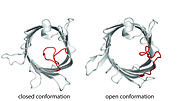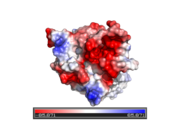Molecular Playground/OmpG
From Proteopedia
Contents |
Outer Membrane Protein G
|
Protein biosensors serve as an analytical device combining a biological component with a physiochemical detector. Through protein engineering we are able to utilize pores as stochastic sensors for single molecule detection. The applications of biosensors range from fundamental research, clinical diagnosis and even advances in homeland security. PCR (Polymerase chain reaction) and ELISA (Enzyme- linked immunosorbent assay) are current sensitive detection methods. However, these methods are time consuming and require laborious effort, where results are provided hours or days later. For this reason alternate approaches are mounting in demands that are rapid in detection time, highly sensitive and reliable.
Conventional nanopore sensing is achieved by monitoring the passage of ionic current through a pore containing natural or engineered recognition sites. Analyte detection is visualized as a change (most commonly as a current blockage) in the ionic current. We will tailor and fine tune monomeric protein, Outer membrane protein G (OmpG) for detecting large analytes.
This monomeric porin has seven flexible loops in which we can attach ligands or insert peptide sequences. Utilizing the flexibility of loop 6, which is the longest and most flexible, we will append ligands and peptide sequences so that our target analytes to bind to OmpG. Location of ligand
Structural Features of OmpG
OmpG is a 14-stranded beta-barrel and in contrast to most porins, appears to function as a monomer.[1] The central pore of OmpG is wider than other E. coli porins and it is speculated that it may form a non-specific channel for the passive transport of large oligosaccharides.[1] OmpG adopts two main conformations: open and closed which is termed gating.
At neutral pH the porin is mainly in an open conformation, with periodic closures. However at a more acidic pH the closed conformation is becomes dominant. This fluctuation between open and closed is a result of OmpG's flexible loop 6 (highlighted in red), which folds across the channel blocking the pore opening. The rearrangement of loop 6 appears to be triggered by a pair of histidine residues, which repel each other at acidic pH, resulting in the breakage of neighbouring H-bonds and a lengthening of loop 6 from 10 to 17 residues[2,3].
[2IWW] [1].
The loop environment of OmpG carries a net negative charge. This highly negative character may be implicated in the gating behavior of OmpG. If we can gain a deeper understanding of the individual loop behavior in the overall gating, we could use this knowledge to tune it for specific detection of a wide variety of target analytes.
Current OmpG Projects in the Chen Lab
Engineering loop 6 to detect large protein analytes
Investigating the effect of loop charge on the gating behavior of OmpG
Additional Resources
Current applications using nanopores for protein detection [2] For additional information, see: Nanobiotechnology Review [3]
References
[1] Chen M, Li Q-H and Bayley, H (2008) "Orientation of the monomeric porin OmpG in planar lipid bilayers." ChemBioChem 9(18):3029-36
[2] Chen M, Khalid S, Sansom M and Bayley H (2008) "Outer membrane protein G: engineering a quiet pore for biosensing." Proc Natl Acad Sci U S A 105: 6272-6277
[3] Damaghi M, Bippes C, et al. (2010) "pH-dependent interactions guide the folding and gate the transmembrane pore of the beta-barrel membrane protein OmpG." J Mol Biol 397(4):878-82.



